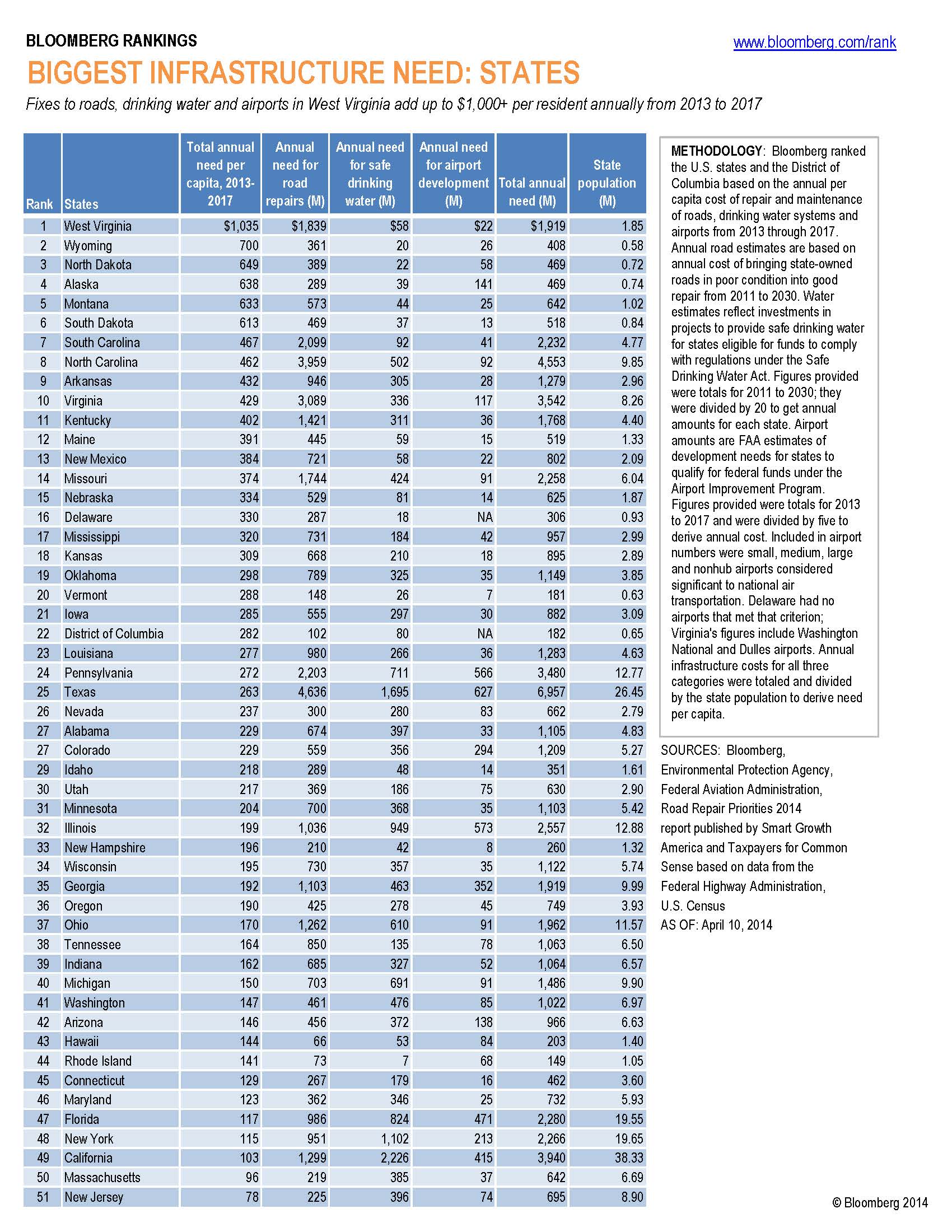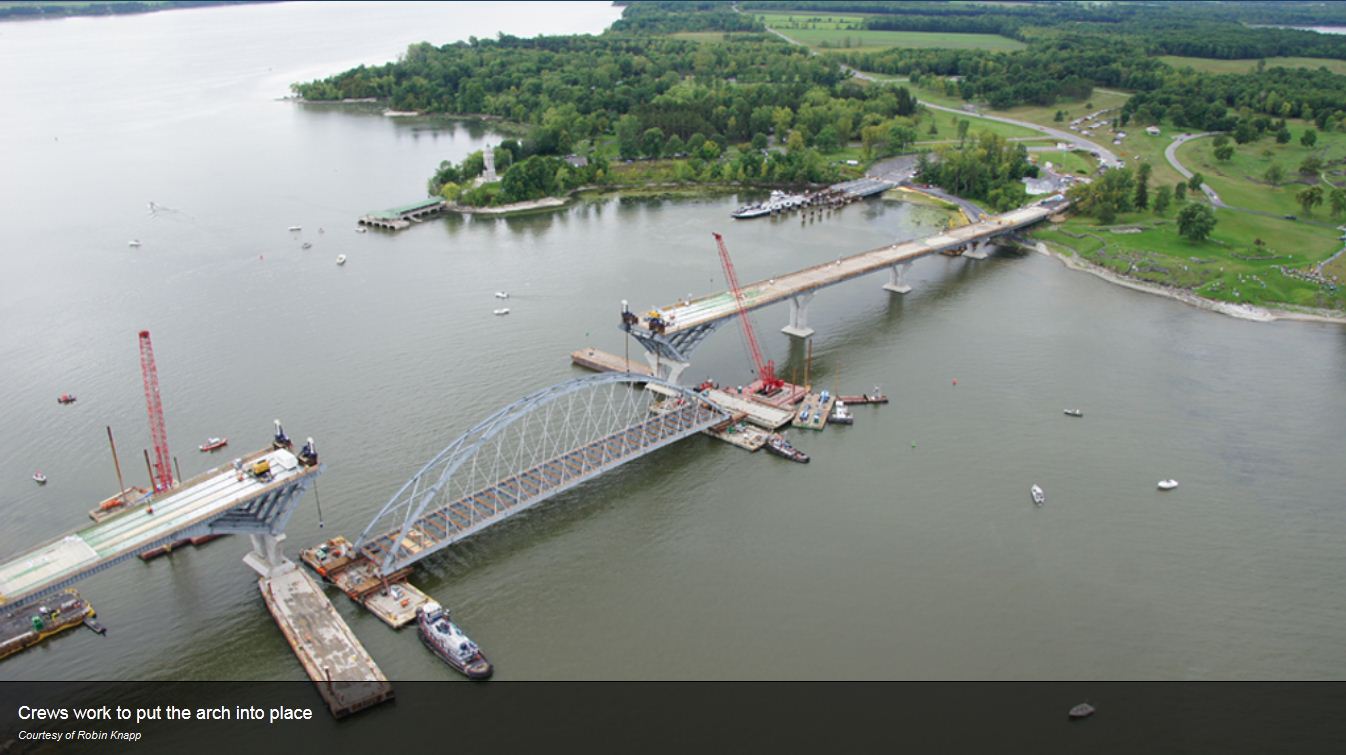New York and Vermont Leadership Make Lake Champlain Bridge Project Success
May 22nd, 2014 | By: Infrastructure Report Card
Commit to Success America’s infrastructure needs a national commitment to bring existing infrastructure into a state-of-good-repair, and in the long term we must modernize and build in a targeted and strategic manner. This means leadership at the federal, state, and local levels of government, by businesses and individuals, to communicate the importance of our nation’s infrastructure, to craft innovative solutions that reflect the diverse needs of the nation, and to make the investments the system needs. By employing strategies to use every dollar more efficiently and by deploying creative solutions to infrastructure development such as public–private partnerships, we can implement the right projects on time at the right price. A Leadership Success StoryIn 2009, civil engineers deemed the Lake Champlain Bridge, connecting Crown Point, New York, to Addison, Vermont, as structurally unsafe, and authorities closed the bridge. By December 2009 it was concluded that the bridge could not be repaired, and the nearly 100-year-old landmark was demolished, removing a key route for area residents.
 Construction began in June 2010 to install a new 2,200 foot long bridge. Despite a harsh winter and spring, construction crews completed the bridge in less than two years, limiting the social and economic impacts. The main arch span was prefabricated off-site, floated by barge to the already constructed approach spans, and then lifted into place. The new bridge also took into account public safety concerns and Complete Streets engineering by including pedestrian and bicycle lanes.
Construction began in June 2010 to install a new 2,200 foot long bridge. Despite a harsh winter and spring, construction crews completed the bridge in less than two years, limiting the social and economic impacts. The main arch span was prefabricated off-site, floated by barge to the already constructed approach spans, and then lifted into place. The new bridge also took into account public safety concerns and Complete Streets engineering by including pedestrian and bicycle lanes.
ASCE Applauds U.S. Senate Conference Report on Water Resources Reform and Development Act
May 15th, 2014 | By: America's Infrastructure Report Card
Washington, D.C. — The following is a statement from Randall (Randy) S. Over, P.E., F.ASCE, president of the American Society of Civil Engineers (ASCE) regarding the conference report on the Water Resources Reform and Development Act by the U.S. Senate: “Today’s release of the conference report on the Water Resources Reform and Development Act (WRRDA) represents a major victory in providing the necessary funding to modernize the nation’s ports, inland waterways, dams and levees. The bill promotes economic growth and job creation through policies that strengthen U.S. infrastructure, allowing the United States to remain competitive in the 21st century. “ASCE’s 2013 Report Card for America’s Infrastructure graded the nation’s ports a C, inland waterways a D-, dams a D, and levees a D-. Our nation’s water resources are critical to our economy, our infrastructure, public safety, and the preservation and enhancement of our environmental resources. In fact, ASCE’s Failure to Act economic study on the nation’s marine ports and inland waterways shows that underinvesting in just these two sectors threatens more than one million U.S. jobs and $270 billion in U.S. exports by 2020. “WRRDA will drastically reduce the time it takes for project approvals by consolidating or eliminating duplicative studies, allowing concurrent reviews, and streamlining environmental reviews. The significant reforms in the law are not at the expense of environmental quality and will allow for a stronger, safer national water resources infrastructure. In addition, ASCE applauds the reauthorization of the National Dam Safety Program, the strengthening of the Levee Safety Initiative, and the efforts to put the trust back into the Harbor Maintenance Trust Fund so that our nation’s ports can remain competitive on a global level. “ASCE is pleased that Congress has collaborated on a final conference report on WRRDA to invest in America’s future. This decisive action will ensure that our nation’s ports, waterways, dams and levees receive much-needed funding. We look forward to the final vote next week and the legislation being signed into law by the president.” Founded in 1852, the American Society of Civil Engineers represents more than 145,000 civil engineers worldwide and is America’s oldest national engineering society.###
Tags: congress, dams, infrastructure, levees, ports, water, wrrda
No Comments »
This Week in Infrastructure: White House offers bill to GROW AMERICA
May 2nd, 2014 | By: Becky Moylan
Congress is back in session, but it was not a member of the legislative branch who introduced legislation to fund transportation projects. Instead, the U.S. DOT and President Obama followed up on a promise from earlier this year to propose a $302 billion transportation budget, titled GROW AMERICA (which stands for Generating Renewal, Opportunity, and Work with Accelerated Mobility, Efficiency, and Rebuilding of Infrastructure and Communities throughout America). Don’t worry, you won’t be tested on the anagram at the end of this post. However, despite a step toward a possible funding option for the Highway Trust Fund, to guarantee it doesn’t become insolvent during the height of summer road construction, Time suspects you didn’t even hear about it. There was some coverage, but it was not splashed across the top of news websites, nor did it get a breaking news app push notification or email (at least not from any I use. If yours did let me know and I will gladly convert). Most notable to the news media was the administration’s proposed shift in current law regarding tolls on interstate freeways. It is an alternative to raising the gas tax that will offer additional revenue, though the law makes it an option for states, rather than a federal mandate. So could the GROW Act be the answer to preventing Washington’s next cliff? Or will Congress put a pothole in its path to better transportation? Several states, including Iowa and Utah, continue to fear the Highway Trust Fund’s insolvency. And a Nevada paper urged that the country needs a plan. Both Rep. Dina Titus and Rep. Bill Shuster wrote in Roll Call this week about the importance of maintaining our infrastructure. It is time to transform these words into actions to #FixtheTrustFund.Tags: congress, gas tax, GROW Act, GROW AMERICA Act, highway trust fund, infrastructure, Tolls, White House
No Comments »
How Much Would You Owe If Everyone's Infrastructure Bill Came Due?
April 29th, 2014 | By: Infrastructure Report Card
Bloomberg took the opportunity to calculate your infrastructure bill for you based on where you live. See what you would owe for roads, safe drinking water, and airport infrastructure if every one in every state had to pay their bill today.
Tags: aviation, bill, infrastructure, rank, roads, water
1 Comment »
This Week in Infrastructure: If not now, when?
April 25th, 2014 | By: Becky Moylan
“It is time to fix our roads and bridges,” House Public Works and Highways Committee Chairman Rep. David Campbell, D-Nashua, [New Hampshire,] said. “If not 4.2 cents, what amount? If not today, when?” With those words of encouragement and a vote, New Hampshire’s legislative branch sent a bill to Gov. Maggie Hassan raising the Gas Tax by 4.2 cents. The governor has said she would sign the bill. Rep. Campbell’s words are ones that apply not only in New Hampshire, but across the country. Finding funding, making the decision to invest, is a slow going process, but the Highway Trust Fund’s clock is ticking. Michigan Governor Rick Snyder also applauded “constructive” strides this week in road funding legislation for his state. States taking positive steps is promising, but without a sustainable funding mechanism for the Highway Trust Fund, will it be enough? The Tennessee DOT commissioner warned this week that the shrinking federal funds will significantly hurt the state’s transportation. In addition to concerns, there were also suggested solutions. One came from U.S. Sen. Carper of Delaware, who discussed his proposal to ensure the Highway Trust Fund keeps up with current and future needs, by raising the tax gas and eventually tying it to inflation. Rep. Bill Shuster, while not outlining a plan, also discussed the importance of fixing the Highway Trust Fund at an event in his home state of Pennsylvania. Interested in a few more reasons that it’s time to #FixtheTrustFund? Gaebler.com, The Atlantic Cities and Bloomberg all offer excellent viewpoints on the topic. As ASCE President Randy Over said “We’re at a critical crossroads.” So if not now, when?Tags: gas tax, highway trust fund, infrastructure, transportation
2 Comments »
Highway Trust Fund 101: What You Need to Know
April 24th, 2014 | By: America's Infrastructure Report Card
The Highway Trust Fund is set to become insolvent this summer, creating exponential negative consequences for our economy. What? When? Why? Find out how it can be fixed and what you can do to help. What is the Highway Trust Fund? The Highway Trust Fund is how Congress provides federal funding for transportation projects. It was created in 1956 to build the Interstate Highway System and now provides funding for roads, bridges, and transit projects across America. The Fund is paid for by the federal motor fuels taxes on gasoline and diesel fuel. Historically, federal highway funding has accounted for approximately 45 percent of what state DOTs spend on highway and bridge capital improvements. Why Does the Federal Government Pay for Roads, Bridges, and Transit? The U.S. Constitution’s Commerce Clause (Article 1, Section 8, Clause 3) grants Congress the power to establish “post roads” and to regulate commerce “among the several states,” allowing the federal government to invest and maintain roads, bridges, and transit. These constitutional responsibilities formed the basis for the U.S. government to play a significant role in our nation’s transportation and infrastructure system. Outside of U.S. law, Adam Smith–seminal economist and often cited as the ‘father of modern economics”–cited infrastructure investment as one to the “three duties” in his famous “The Wealth of Nations”:“…the duty of erecting and maintaining certain public works and certain public institutions, which it can never be for the interest of any individual, or small number of individuals, to erect and maintain; because the profit would never repay the expense to any individual or small number of individuals, though it may frequently do much more than repay it to a great society.”
What is the Gas Tax? The first federal gas tax was established in 1932 (1 cent/gallon). The gas tax was tied to the Highway Trust Fund in 1956 via The Highway Revue Act and the creation of the Interstate Highway System. The federal gas tax has been raised a number of times since, including by Presidents Reagan, George H.W. Bush, and Clinton. The last time the U.S. federal gas tax was raised was 1993 to 18.4 cents per gallon. It was not been raised in over twenty years. How is the Fund Doing? The U.S. Department of Transportation projects that the Highway Account of the Highway Trust Fund will run out of money for new projects as early as July. For the 10 year window, 2015-2024, the cumulative shortfall in the highway and mass transit accounts of the HTF will be over $170 billion. According to the Congressional Budget Office, to prevent insolvency of the Highway Trust Fund in 2015, federal surface transportation investment would have to be cut by 92 percent that year. Why is the Highway Trust Fund Quickly Becoming Insolvent? The Fund is paid for by the federal gas tax. The gas tax has not been raised in over twenty years. Many items have doubled or tripled their cost since 1993. For example, a new car cost $12,750 in 1993, yet in 2013 a new car cost $31,252. The easiest explanation is that we are trying to build a 2014 infrastructure system with 1993 dollars. This is obviously an untenable formula. How Does the Insolvency Affect Me? Almost half of capital investments made by states on our nation’s roads, bridges, and transit systems are supported by the federal highway and transit programs administered by the U.S. Department of Transportation. Already, infrastructure projects are being slowed or stopped because of the uncertainty surrounding the Highway Trust Fund. Any delay in reimbursement from FHWA will prevent states from being able to pay contractors in a timely manner. Contractors who rely on prompt payment from the state won’t be able to pay their employees and suppliers. Disruptions to this process have the potential to send unwelcome shockwaves throughout our economy, decreasing spending, hiring, and damaging any ability to plan for future projects. We Knew this Was Coming, Right? Oh yes. As far back as 1997, Congress was moving money from the General Fund into the Highway Trust Fund. Recently, in 2008, Congress moved $34.5 billion to the trust fund from the general fund to keep it solvent. So Why Haven’t We Fixed it Before Now? One word: Politics. In order to make the Trust Fund solvent, Congress would need to find a long-term, sustainable solution. Because of how the Fund is currently structured, according to commentators such as Matt Yglesias, the easiest way to do that would be to raise the gas tax to a modern rate and tie the rate to inflation. This would raise needed revenue and assure that future insolvencies would not occur. Obviously, given the climate of fiscal restraint as well as the escalating cost of gasoline over the last twenty years, raising the gas tax has been politically impalpable. And, since any solution outside of raising the gas tax would have to involve dramatically restricting the funding mechanism of the Trust Fund, such proposals have been unable to move forward. What Can I Do? We have to tell Congress to act now. We are using #FixTheTrustFund across all of our social media platforms to spread our message the letting the Trust Fund become insolvent is unacceptable. We have also set up a Legislative Action Center, where you can send you Congressman a message about how the Highway Trust Fund is going to affect you. Good luck and let’s #FixTheTrustFundTags: Constitution, gas tax, highway trust fund, infrastructure, transportation
4 Comments »
This Week in Infrastructure: Highway Trust Fund Gets Media Attention
April 18th, 2014 | By: Becky Moylan
On a typical day, a Google news search for the Highway Trust Fund over the past 24 hours results in a page or two of results. But this week Wednesday, the search query garnered nine pages of hits, and the option to “explore in depth” 166 articles. What did these articles say? And why does it matter? Well, the articles report what those following closely already knew: Congress is giving states the transportation blues. Less reported, while perhaps more newsworthy for the people who specifically seek out the Highway Trust Fund in the news, the USDOT announced its latest projections on when the money will run short, currently predicted as the end of July. This latest warning comes as Transportation Secretary Foxx bus tours across eight states, raising awareness of what he refers to as “clearly a crisis.” Several states progressed with transportation project legislation this week including Connecticut, Massachusetts and Virginia, but without reliable funding for the Highway Trust Fund, it’s unclear how realistic these proposals are. Many cities are considering public-private partnerships (P3s) as an alternative. As the president emeritus of Harvard wrote this week “now is the time” to find the funding and rebuild our nation’s infrastructure. A great first step to do that is to fix the Trust Fund.Tags: congress, highway trust fund, infrastructure, P3
No Comments »
This Week in Infrastructure: Reasons to Keep Advocating for Investment
April 11th, 2014 | By: Becky Moylan
The Opinion Pages of The New York Times presented a series of reasons “We Should Be in a Rage” and among them were—you guessed it—because of the state of our nation’s infrastructure. These grievances, along with suggestions and productive dialogue to change it, appeared in print across the country this week. In Mississippi, one writer named legislators’ neglect as the reason for low grades, and given that the state legislature once again passed on increasing the state gas tax, the frustration is understandable. For, as the Mayor of San Diego demonstrated, improving infrastructure takes time and money. Infrastructure provides a better quality of life, and as the decision-makers continue to appreciate its significance, new ideas for funding are being implemented. The desire to have long-term plans is also a promising development, especially as it could help combat the issues many states—including Oregon and Wisconsin—are currently facing. The watershed law Pennsylvania enacted last fall is proving the value of a strong transportation bill. Such legislation is unfortunately still often only discussed and debated and not enacted, including this week in Illinois and Indiana. New transportation legislation is also currently just a goal at the federal level. However, on Thursday Sen. Boxer and fellow senators announced the Environment and Public Works Committee’s commitment to a six-year bill to replace MAP-21, the current law authorizing the Highway Trust Fund. While only the start of a long process, this at least means state DOTs can rest a little easier, and continue with transportation projects and the jobs that come with them.Tags: congress, highway trust fund, infrastructure, MAP-21, P3
No Comments »



 */ ?>
*/ ?>














